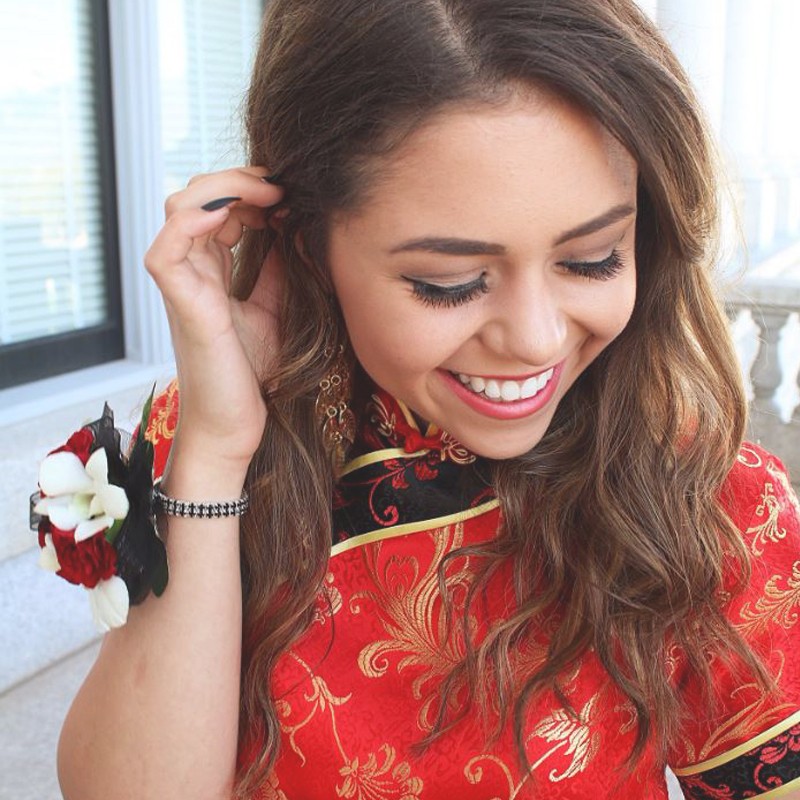Why This Girl’s Prom Dress Is Causing Controversy
Keziah, an 18-year-old student from Utah, wore what is known as a qipao in traditional Chinese culture. The dress dates back to Manchu-ruled China in the 17th century, and originally had a loose, wide fit, which covered most of women’s bodies. However, over time, the qipao became tighter and more fitted as a sign on femininity and confidence, much like Keziah’s dress in the pictures she uploaded to her Twitter.
However, Keziah is not of Asian descent. Users began questioning her ethnicity after she posted the prom photos, and when she responded to comments and revealed she isn’t of Chinese heritage, many felt the dress was problematic. “I wouldn’t wear traditional Korean, Japanese or any other traditional dress and I’m Asian,” said one commenter. “My culture is NOT your goddamn prom dress,” said another.
Others took offence to a photo in which Keziah and her friends are posing with prayer hands and peace signs, which some have interpreted as a stereotypical representation of Asian people and their culture. But Keziah told Teen Vogue that it was a big misunderstanding: “The signs and hand signals had nothing to do with the culture,” she said. “They were in reference to a famous YouTuber named Ethan Klein from h3h3 productions. For example, the praying signal means ‘Papa Praise’ and the other one is ‘Vape Nation.’”
She also said that she chose the dress because she thought it was stunning: “I bought the dress because [of] how beautiful it was,” she said. “I never intended to send the wrong message of me being racist. I love all cultures and have so much respect for them. I'm simply showing my appreciation and in no way am I making fun of the culture.”
But despite the backlash, Keziah wrote on Twitter that she would not be taking the picture down because she feels she has done nothing wrong. “It’s a f**king dress,” she said, “and it’s beautiful.”
Some Twitter users have come out in support for Keziah. “I’m Asian and I’m not insulted in any way. You look beautiful,” one user wrote. “I am Chinese and I approve this,” said another. “What an awesome sense of fashion! Thanks for appreciating our culture!”
This isn’t the first time appropriation of Chinese culture has made the headlines – in 2013, Katy Perry was called out for wearing a Japanese kimono, on a set complete with rice paper screens, fan dancers and cherry blossoms. Jeff Yang of the Wall Street Journal called it a “whiteface/yellowface performance,” and the Atlantic’s Nolan Feeney stated that “it’s these kinds of stereotypical visuals that play into white fetishisation of Asian women – something Perry doesn’t have to deal with when she takes off her costume”.
Writers like Allure’s Sable Yong have lamented that Asian-inspired fashion only seems to be cool when it’s worn by white women, especially considering that the models used for advertising kimonos, cheongsams and Asian prints are not of Asian descent. And it’s true – websites like Zara and ASOS largely use white models for clothes that take inspiration from Asian culture.
Alexa Chung created a number of Asian-inspired dresses for her eponymous fashion line in 2017, but as Yong says, Chung is part-Asian, which takes away the element of appropriation. “There is absolutely no questioning that Alexa is ‘Asian enough’,” she wrote. “In fact, if there was anyone who could single-handedly make a mandarin collar come back with a vengeance it would be her.” However, Chung also came under fire for not employing Asian models to wear her designs.
As for those on the other side of the cultural appropriation debate, Medium’s Sonny Hallett insists the idea that “certain types of clothing, activities, food, etc, can only be worn, mastered or enjoyed by certain peoples can only serve to divide and alienate… Telling me that only I can openly and without challenge celebrate Chinese New Year or wear qipao or teach Chinese cookery can only serve to promote the idea of me as an exotic other, or Chinese stereotype, as things deemed to be culturally ‘mine’ become off-limits to anyone not Chinese, or at least East Asian.”
Hallett adds that we have to learn to learn to distinguish the difference between those being racist – which needs to be called out – and those who are simply ignorant. For the latter, help can be given by sensitively adding more information – which could be really helpful in the case of Keziah.
DISCLAIMER: We endeavour to always credit the correct original source of every image we use. If you think a credit may be incorrect, please contact us at info@sheerluxe.com.



